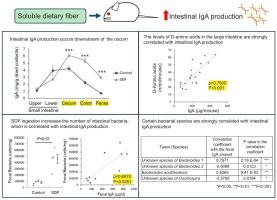Intestinal D-amino acids content is highly related to intestinal IgA production upon soluble dietary fiber ingestion in mice
IF 9.8
1区 农林科学
Q1 CHEMISTRY, APPLIED
引用次数: 0
Abstract
Soluble dietary fiber (SDF) induces intestinal IgA production. Mechanistically, this has primarily been explained by intestinal bacteria producing short-chain fatty acids (SCFAs) as metabolites from the SDF. Here, we aimed to identify factors other than SCFAs that contribute to SDF-induced intestinal IgA production. SDF ingestion (3 % of the diet) for 9–12 weeks induced a four-fold increase in fecal IgA production in BALB/cA mice. The total SCFA concentration in the cecum tends to show a positive correlation with fecal IgA content (ρ = 0.5734, P = 0.0513), while the content of D-amino acids (D-AAs), inducers of IgA, in the cecum and colon exhibited a strongly positive correlation with the IgA content (ρ = 0.7805, P < 0.001). Bacterial flora analysis of fecal samples revealed that certain bacterial species were highly correlated with IgA production. These findings suggest that D-AAs play an important role in SDF-induced intestinal IgA production.


肠道d -氨基酸含量与摄入可溶性膳食纤维后肠道IgA的产生高度相关
可溶性膳食纤维(SDF)诱导肠道产生IgA。从机制上讲,这主要是由肠道细菌产生短链脂肪酸(SCFAs)作为SDF的代谢物来解释的。在这里,我们的目的是确定SCFAs以外的因素有助于sdf诱导的肠道IgA产生。在BALB/cA小鼠中,连续9-12 周摄入SDF(占日粮的3% %)可使粪便IgA产量增加4倍。盲肠SCFA总浓度与粪便IgA含量呈显著正相关(ρ = 0.5734,P = 0.0513),盲肠和结肠中IgA诱导性物质d -氨基酸(D-AAs)含量与IgA含量呈显著正相关(ρ = 0.7805,P <; 0.001)。粪便样品的细菌菌群分析显示,某些细菌种类与IgA的产生高度相关。这些发现表明,D-AAs在sdf诱导的肠道IgA产生中起重要作用。
本文章由计算机程序翻译,如有差异,请以英文原文为准。
求助全文
约1分钟内获得全文
求助全文
来源期刊

Food Chemistry
工程技术-食品科技
CiteScore
16.30
自引率
10.20%
发文量
3130
审稿时长
122 days
期刊介绍:
Food Chemistry publishes original research papers dealing with the advancement of the chemistry and biochemistry of foods or the analytical methods/ approach used. All papers should focus on the novelty of the research carried out.
 求助内容:
求助内容: 应助结果提醒方式:
应助结果提醒方式:


